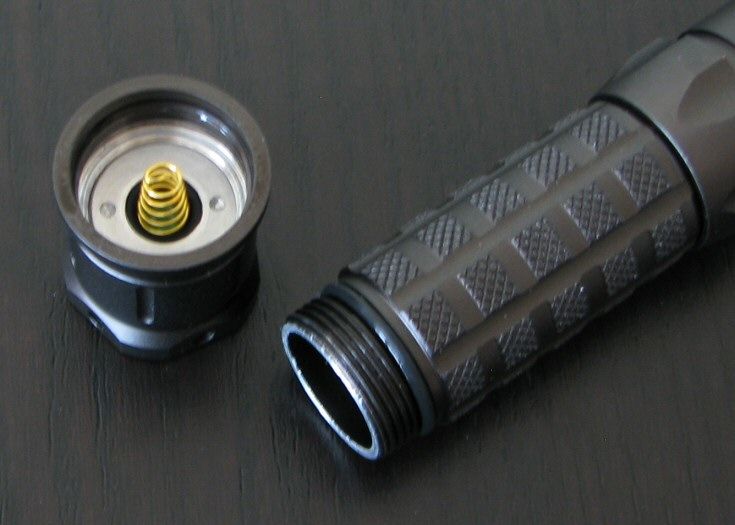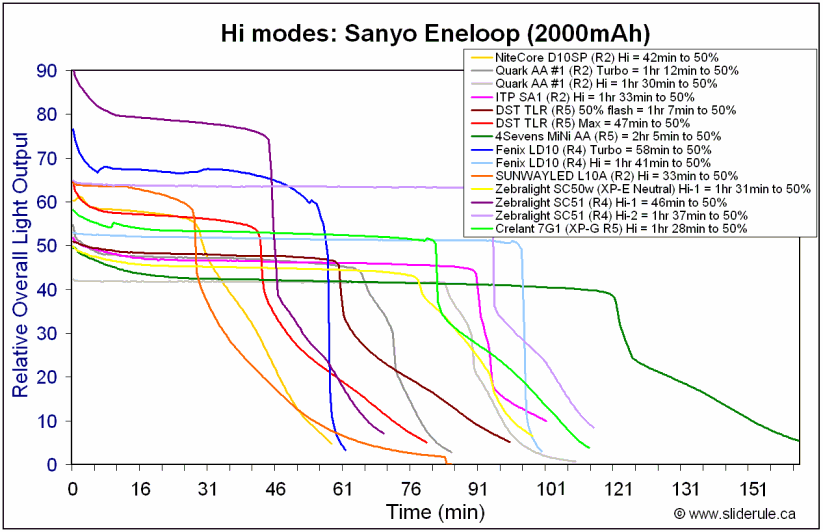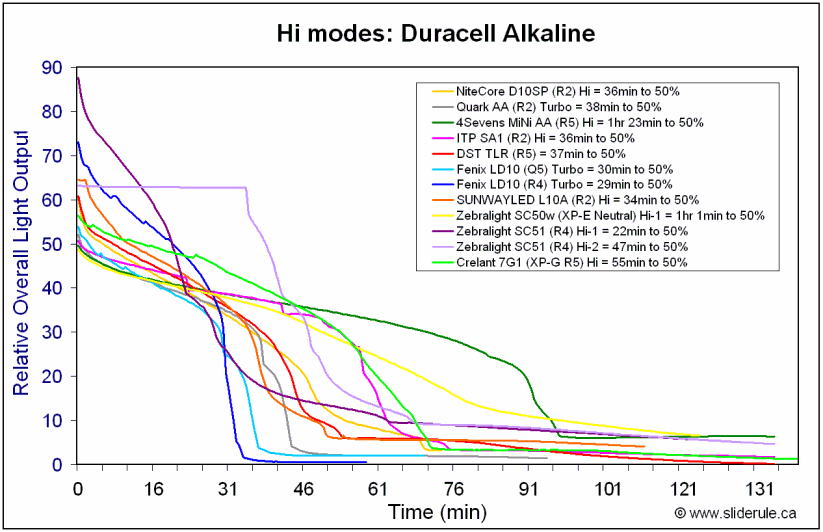Warning: pic heavy, as usual. 

Specifications:


Packaging is fairly basic, clearly designed for a store shelf. Inside the cardboard box with plastic insert is the light, manual, spare o-rings, and extra boot cap.


From left to right: Duracell AA, Crelant 7G1, Fenix LD10-R4, 4Sevens Quark AA, Zebralight SC51, Nitecore D10SP
7G1: Weight: 47.5 g (no batteries), Length 100.8mm x Width 21.1mm (bezel)



Build quality seems high, with a lot of nice touches (e.g. the stainless steel bezel ring).
Light feels reasonably solid for this class. There are a lot of body details to help with grip, including fairly good knurling and a lot of ridge detail
Screw threads are anodized at the tailcap for lock-out.
Anodizing is excellent on my sample, no chips in the dark gray natural finish (HA = type III). Lettering is sharp and clear, but not overly bright (which is good, because there are a lot of labels on the head).
Switch is a reverse clicky, which is a bit of a surprise. The light tailstands, but just barely - my sample is rather wobbly. I understand this is supposed to be improved on later builds. If you find it an issue, a bit of adjusting of the tailcap switch may help.
The is no clip or wrist strap included with the light.


The 7G1features the Cree XP-G R5, with a lightly textured (LOP) deep reflector.
Which brings us to the requisite white wall hunting . All lights are on Hi on Sanyo Eneloop, about ~0.75 meter from a white wall (with the camera ~1.25 meters back from the wall). Automatic white balance on the camera, to minimize tint differences.
. All lights are on Hi on Sanyo Eneloop, about ~0.75 meter from a white wall (with the camera ~1.25 meters back from the wall). Automatic white balance on the camera, to minimize tint differences.
















From now on, all my beamshots will be taken in this standard configuration, to facilitate comparisons.
As you can see, the 7G1 has a nice and smooth beam. It may not be as high on Max as some of the more recent heavily-driven lights, but is still quite reasonable for this class. Scroll down to my Summary Tables for more specifics.
User Interface
Turn the light on by pressing the tailcap clicky (press for momentary on, click for locked on).
With the head fully tightened, you get Max output.
Loosen the head a quarter turn or more, and you get all the other modes. The default setting is Strobe, and you advance through the various modes by a soft-press of the clicky. Sequence is Strobe > Lo > Med > Hi, in repeating sequence. There is a memory mode, so the light will recall your preference for the head-loosened mode.
Pretty straight-forward.
PWM and Strobe


The 7G1 uses PWM on its Med and Lo mode, at the visually-undetectable frequencies of 4.86 kHz and 4.95 kHz, respectively.

Strobe is 10 Hz.
Testing Method:
All my output numbers are relative for my home-made light box setup, a la Quickbeam's flashlightreviews.com method. You can directly compare all my relative output values from different reviews - i.e. an output value of "10" in one graph is the same as "10" in another. All runtimes are done under a cooling fan, except for any extended run Lo/Min modes (i.e. >12 hours) which are done without cooling.
I have recently devised a method for converting my lightbox relative output values (ROV) to estimated Lumens. See my How to convert Selfbuilt's Lighbox values to Lumens thread for more info.
Throw/Output Summary Chart:
Effective November 2010, I have revised my summary tables to match with the current ANSI FL-1 standard for flashlight testing. Please see http://www.sliderule.ca/FL1.htm for a description of the terms used in these tables.


On standard batteries, the 7G1 has reasonably good output and throw – although not as high as some of the recent heavily-driven 1xAA lights. However, the 7G1 fully supports 14500, where output is considerably higher.
Output/Runtime Comparison:








Output/runtime performance is good overall.
On standard alkalines, it nearly matches the current-controlled Fenix LD10-R4. oo: On NiMH (Eneloop), performance is ok - not as impressive as the alkaline performance, but still good for a PWM-based light.
oo: On NiMH (Eneloop), performance is ok - not as impressive as the alkaline performance, but still good for a PWM-based light.
On 14500, performance is very good for this class.
Potential Issues
Tailstanding ability is borderline on my sample, despite the use of a reverse clicky. However, this may have been resolved on later builds.
Max output is lower than some of the recent XP-G R4/R5-equipped lights.
Light lacks a "moonlight" mode.
Bundled extras are fairly limited.
Preliminary Observations
The 7G1 is a quality light. As always, design is a matter of personal taste, and the 7G1 has one of the most "rakish" looks out there. But it has excellent grip, and a lot of nice design touches.
Performance-wise, overall circuit efficiency on NiMH or L91 seems reasonable for a PWM-based light (especially one with such a high frequency :thumbsup . But the light seems to be optimized for standard alkaline cells, where it performs close to the level of a good current-controlled light.
. But the light seems to be optimized for standard alkaline cells, where it performs close to the level of a good current-controlled light.  oo: Performance on 14500 (which are officially supported) also seems very good.
oo: Performance on 14500 (which are officially supported) also seems very good.
One issue for some may be the Max output - it is not as heavily-driven as some of the other recent XP-G R4/R5 AA-sized lights. To give you an idea, max output on the 7G1 is closer to the Fenix Hi mode (which is a bit lower than the Zebralight SC51 secondary Hi mode). But it's still plenty of light for the job, and ensures a reasonable runtime.
Personally, I'm glad to see the return of high frequency PWM. There has been a trend lately to downgrade to visible PWM in order to boost efficiency. For the visibly-undetectable PWM used here, performance is still quite good (remarkably so on alkalines).
One thing I would definitely like to see is a lower Lo mode. After all, that is one of the advantages of a PWM-based light - the ability to run at lower outputs than the current-controlled circuits. And a few extra bundled accessories would be nice (i.e. a clip and holster). But it is a nicely built light as it stands. I'm looking forward to seeing what they come up with next.
----
7G1 provided by Crelant for review.

Specifications:
- LED: CREE XP-G R5
- Function: High - Low - Strobe
- 1 x AA Battery:
- High output: 138 Lumen for 108 minutes
- Low output: 60 Lumen for 3 hours
- Strobe: 10 Lumen for 36 hours
- 1 x 14500 Li-ion Battery
- High output: 228 Lumen for 90 minutes
- 2. Low output: 80 Lumen for 3 hours
- 3. Strobe: 10 Lumen for 24 hours
- Reflector: High efficient smooth reflector with aluminum bezel.
- Size: Length 100mm, Body Diameter 21mm
- Type-III hard anodize high quality aerospace grade T6061 aluminium construction
- Water proof: waterproof to 5m/15ft
- Tactical type switch: High/Low/Strobe/Off
- Weight: 50 g / less than 2 ounces excluding the battery.
- Included in the box: Lanyard, Tail Cap Button, Spare O-Rings
- Estimated MSRP ~$69


Packaging is fairly basic, clearly designed for a store shelf. Inside the cardboard box with plastic insert is the light, manual, spare o-rings, and extra boot cap.


From left to right: Duracell AA, Crelant 7G1, Fenix LD10-R4, 4Sevens Quark AA, Zebralight SC51, Nitecore D10SP
7G1: Weight: 47.5 g (no batteries), Length 100.8mm x Width 21.1mm (bezel)



Build quality seems high, with a lot of nice touches (e.g. the stainless steel bezel ring).
Light feels reasonably solid for this class. There are a lot of body details to help with grip, including fairly good knurling and a lot of ridge detail
Screw threads are anodized at the tailcap for lock-out.
Anodizing is excellent on my sample, no chips in the dark gray natural finish (HA = type III). Lettering is sharp and clear, but not overly bright (which is good, because there are a lot of labels on the head).
Switch is a reverse clicky, which is a bit of a surprise. The light tailstands, but just barely - my sample is rather wobbly. I understand this is supposed to be improved on later builds. If you find it an issue, a bit of adjusting of the tailcap switch may help.
The is no clip or wrist strap included with the light.


The 7G1features the Cree XP-G R5, with a lightly textured (LOP) deep reflector.
Which brings us to the requisite white wall hunting
















From now on, all my beamshots will be taken in this standard configuration, to facilitate comparisons.
As you can see, the 7G1 has a nice and smooth beam. It may not be as high on Max as some of the more recent heavily-driven lights, but is still quite reasonable for this class. Scroll down to my Summary Tables for more specifics.
User Interface
Turn the light on by pressing the tailcap clicky (press for momentary on, click for locked on).
With the head fully tightened, you get Max output.
Loosen the head a quarter turn or more, and you get all the other modes. The default setting is Strobe, and you advance through the various modes by a soft-press of the clicky. Sequence is Strobe > Lo > Med > Hi, in repeating sequence. There is a memory mode, so the light will recall your preference for the head-loosened mode.
Pretty straight-forward.
PWM and Strobe


The 7G1 uses PWM on its Med and Lo mode, at the visually-undetectable frequencies of 4.86 kHz and 4.95 kHz, respectively.

Strobe is 10 Hz.
Testing Method:
All my output numbers are relative for my home-made light box setup, a la Quickbeam's flashlightreviews.com method. You can directly compare all my relative output values from different reviews - i.e. an output value of "10" in one graph is the same as "10" in another. All runtimes are done under a cooling fan, except for any extended run Lo/Min modes (i.e. >12 hours) which are done without cooling.
I have recently devised a method for converting my lightbox relative output values (ROV) to estimated Lumens. See my How to convert Selfbuilt's Lighbox values to Lumens thread for more info.
Throw/Output Summary Chart:
Effective November 2010, I have revised my summary tables to match with the current ANSI FL-1 standard for flashlight testing. Please see http://www.sliderule.ca/FL1.htm for a description of the terms used in these tables.


On standard batteries, the 7G1 has reasonably good output and throw – although not as high as some of the recent heavily-driven 1xAA lights. However, the 7G1 fully supports 14500, where output is considerably higher.
Output/Runtime Comparison:








Output/runtime performance is good overall.
On standard alkalines, it nearly matches the current-controlled Fenix LD10-R4.
On 14500, performance is very good for this class.
Potential Issues
Tailstanding ability is borderline on my sample, despite the use of a reverse clicky. However, this may have been resolved on later builds.
Max output is lower than some of the recent XP-G R4/R5-equipped lights.
Light lacks a "moonlight" mode.
Bundled extras are fairly limited.
Preliminary Observations
The 7G1 is a quality light. As always, design is a matter of personal taste, and the 7G1 has one of the most "rakish" looks out there. But it has excellent grip, and a lot of nice design touches.
Performance-wise, overall circuit efficiency on NiMH or L91 seems reasonable for a PWM-based light (especially one with such a high frequency :thumbsup
One issue for some may be the Max output - it is not as heavily-driven as some of the other recent XP-G R4/R5 AA-sized lights. To give you an idea, max output on the 7G1 is closer to the Fenix Hi mode (which is a bit lower than the Zebralight SC51 secondary Hi mode). But it's still plenty of light for the job, and ensures a reasonable runtime.
Personally, I'm glad to see the return of high frequency PWM. There has been a trend lately to downgrade to visible PWM in order to boost efficiency. For the visibly-undetectable PWM used here, performance is still quite good (remarkably so on alkalines).
One thing I would definitely like to see is a lower Lo mode. After all, that is one of the advantages of a PWM-based light - the ability to run at lower outputs than the current-controlled circuits. And a few extra bundled accessories would be nice (i.e. a clip and holster). But it is a nicely built light as it stands. I'm looking forward to seeing what they come up with next.
----
7G1 provided by Crelant for review.
Last edited:

